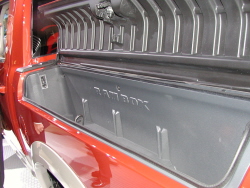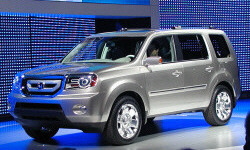So, what else did I see at this year’s less than inspiring Detroit auto show?
The general impression was that every company sought to portray itself as green. And there were various hybrid, fuel cell, diesel, and so forth concepts on display. But with few exceptions they were just that, concepts. I’ll get more excited when they’re available to buy–at a reasonable price.
I add that last bit because GM did show “two-mode hybrid” and “plug-in hybrid” variants of its Saturn VUE compact SUV, and these will be available in the next year or two. The big question: how much will they cost? As I wrote earlier in this blog, the “two-mode” version of the Chevrolet Tahoe costs about $10,000 more than its non-hybrid counterpart when features are adjusted for. If the “two-mode” VUE checks in at $35,000+, I suspect the market for it will be quite limited.
From a sales standpoint, the most important introductions were undoubtedly those of the revised Ford F-150 and Dodge Ram pickups. In neither case is the revised styling a home run, and the Dodge’s new Tundra-like nose is especially disappointment. Both trucks also benefit from upgraded interiors, with Chrysler’s Jim Press suggesting that the new Ram interior indicates how much higher in quality future Chrysler interiors will be. Well, while the improvement in the Ford interior is somewhat impressive, the revised Dodge Ram interior remains clearly inferior to both that in the Ford and that in GM’s pickups. Sure, they’ve upholstered the top of the instrument panel, but even this manages to look cheap. And the rest remains hard plastic that looks like hard plastic.
 Most impressive about the pickups: all of the new features Ford and Dodge have added. Both manufacturers appear to have decided that the best way to counter increasing competition in the segment is to meet previously unmet needs. So we have additional storage compartments, track systems in the beds, trick integrated bed extenders, and so forth. Most interesting on the Ford: steps on the sides and rear to ease access over the tall sides of the bed. On the Dodge: a four-cubic-foot storage compartment in each side of the new “Ram Box” bed. Together they offer as much storage volume as a small trunk. And you can get to them when the bed is loaded. Take that, Honda!
Most impressive about the pickups: all of the new features Ford and Dodge have added. Both manufacturers appear to have decided that the best way to counter increasing competition in the segment is to meet previously unmet needs. So we have additional storage compartments, track systems in the beds, trick integrated bed extenders, and so forth. Most interesting on the Ford: steps on the sides and rear to ease access over the tall sides of the bed. On the Dodge: a four-cubic-foot storage compartment in each side of the new “Ram Box” bed. Together they offer as much storage volume as a small trunk. And you can get to them when the bed is loaded. Take that, Honda!
The car I’m most looking forward to test-driving: the 2009 Mitsubishi Lancer Ralliart. With a 235-horsepower 2.0-liter turbo four, all-wheel-drive, sport buckets, and a price likely in the mid-twenties, it’ll hit a sweet spot that was owned by the Subaru WRX–until the botched 2008 redesign.
The car most essential to the survival of its brand: the 2009 Lincoln MKS. The upcoming large Lincoln sedan checks off all of the boxes. Like the Taurus on which it is based, the MKS will be a good car for those who buy a car for rational reasons. It’s reasonably powerful, very roomy, comfortable, and pleasantly styled. But it also shares the Taurus’ weakness: it won’t stand out in the crowd, and no one’s going to lust after it.
 No one’s going to lust after the redesigned 2009 Honda Pilot, either. Luckily for Honda, people are more likely to buy an SUV for rational reasons than they are to buy a luxury sedan for rational reasons. Especially when it’s a Honda. How else to explain the success of the even more boring first-generation Pilot over the last five years?
No one’s going to lust after the redesigned 2009 Honda Pilot, either. Luckily for Honda, people are more likely to buy an SUV for rational reasons than they are to buy a luxury sedan for rational reasons. Especially when it’s a Honda. How else to explain the success of the even more boring first-generation Pilot over the last five years?
I was able to take a close look at the redesigned 2009 Nissan Murano, which should be reaching dealers soon if it hasn’t already. The styling of the first-generation Murano really grew on me. The new styling is more forced and cluttered, and I don’t care for it nearly as much. However, the revised interior is significantly nicer, and the seats are excellent in both rows. From a comfort standpoint, they were about the best I sat in at the whole show.